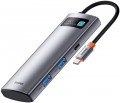USB version
This paragraph refers to the USB connection interface. Refers to both the classic USB A and the type C port. The main difference between the interface versions is the bandwidth — speed.
—
USB 2.0. The outdated version 2.0 provides data transfer rates up to 480 Mbps. Found only in USB A ports.
—
USB 3.2 gen1. The previous names of the USB 3.1 gen1 and USB 3.0 standard (they know how to confuse). Unlike 2.0, this version provides 10 times the maximum speed (4.8 Gbps), as well as higher power supply, which allows you to connect power-hungry devices and extensive splitters.
—
USB 3.2 gen2. Further improvement of the USB 3.2 gen1 standard (and, as is customary, the previous name USB 3.1 gen1 and simply USB 3.1, which was renamed more than once), made it possible to achieve a maximum speed of 10 Gbps and even higher power for external devices.
USB C
The number of USB Type C ports for connecting peripherals provided in the design of the hub (or card reader with the hub function — see "Type").
The port itself is small — only slightly larger than microUSB — and has a reversible design, thanks to which the plug can be inserted in either direction. That is why he has exacted respect and is actively replacing the classic USB port.
Despite its small size, USB Type C is used both in portable technology and in desktop PCs and peripherals for them. However, there are still few such devices available; because of this, hubs usually provide
1 USB-C port or
2 type C inputs.
USB-C version
The USB connector interface (version) primarily characterizes the speed.
- 2.0. The outdated version 2.0 provides data transfer rates up to 480 Mbps. Found only in USB A ports.
— 3.2 gen1. Previous standard names are 3.1 gen1 and 3.0. This version provides up to 10 times the maximum speed (4.8Gbps) as well as higher power capacity, which allows you to connect power-hungry devices and large splitters.
- 3.2 gen2. Further improvement of the 3.2 gen1 standard (and, as is customary, the previous name more than once renamed 3.1 gen1 and simply 3.1), which made it possible to achieve a maximum speed of 10 Gbps and even higher power for external devices.
However, the final speed depends not so much on the input connector, but on the USB version of the hub (card reader) connection to the PC.
External power supply
External USB devices require power to work, which is supplied to them through the same USB port. However, the power of such power supply is relatively low (especially in version 2.0 ports, see "Connection"), and if several external devices are connected to one port of the computer through a hub, a situation may arise when the power is not enough for their operation.
Connecting an external power supply to the hub allows you to avoid such situations: the hub receives additional power from the network and supplies power of the appropriate power to each of its inputs.
Another option for using devices with this function is charging portable equipment via USB: some models can work as stand-alone chargers that do not require connection to a computer.
Power Delivery
The technology allows you to work at higher voltage, thereby increasing the transmitted power.
USB hubs with Power Dlivery can not only charge smartphones faster, but also power more power-hungry devices, such as laptops.
Activity indicator
Light indicator, indicating that data is currently being exchanged between the memory card and the computer to which the card reader is connected. This allows you to avoid disconnecting the card reader during operation, which is fraught not only with data loss, but even damage to the device.

